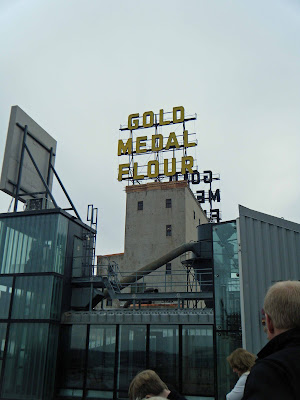An excursion on the web revealed that parking around the museum was a bit expensive. So I took myself out for breakfast, left my car in the restaurant lot, and hopped a bus to the 46th Street Station of the light rail.
Boy, was I surprised! I haven't been there in over a year and in that time a huge apartment complex has been built in the station area.
The buses now approach the station area by coming through the arch way. It has a very European feel to it.
Soon I was away on a train to the Metrodome stop.
From the stop it was a 4 block walk to the museum. It is located in the Washburn-Crosby mill.
A bit of background. Minneapolis was the world capital of flour milling for over 50 years, starting from the 1870s and ending with the economic changes of the Great Depression in the 1930s. Wheat came from Minnesota and the Dakotas primarily.
The building in which the museum is housed today was built in the late 1870s. It replaced one destroyed by a great explosion. This is how it looked when completed.
 The The |
| Photo of a museum sign |
The elevator would stop and the doors would open to a display.
Below is a video of one of the scenes.
The above machine somehow gathered flour dust out the air, and then the flour was somehow incorporated back in the milling process. Flour milling was a very dusty business; this is what led to the explosion that destroyed the first mill in this area. Workers also got "miller's lung," a type of occupational asthma.
On the eighth floor we were also on a level for observation deck.
We had a good view of St. Anthony Falls, the only waterfall on the Mississippi River. It was the power of the water that brought the mills into this area. The waterfall looks quite tamed now, nothing like its original state.
Through the library web site for the Minnesota History Center I obtained a copy of Bierstadt's painting of St. Anthony Falls. I felt badly about what we had done to this area. Then later in my visit I learned why it looks like it does today.
Turns out it was quite common to attempt to tunnel under the river. One tunnel collapsed and nearly destroyed the waterfall. What we see today is in fact an attempt to maintain it as much as possible.
From the observation deck I noticed the sign across the river for the Pillsbury Mill.
Nearby is the sign for Gold Medal.
Please see the next post. When I was writing this one, Blogger refused to take more content. So I wrote a second post about more of this experience.








No comments:
Post a Comment